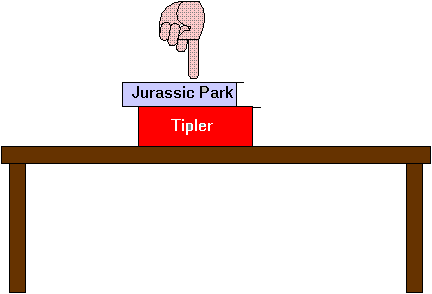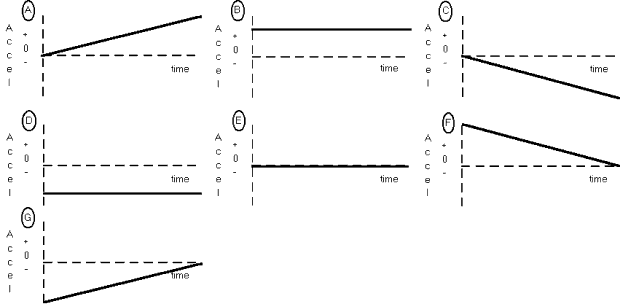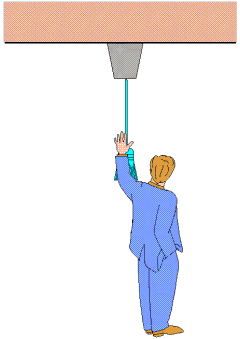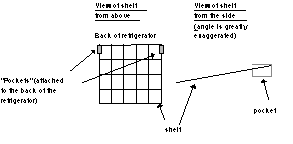1) A Frenchman, filling out a form writes "78 kg" in the space
marked Poids (weight). However, weight is a force and the kg is a mass
unit. What do the French (among others) have in mind when they use a mass
to report their weight? Why don't they report their weight in newtons?
How many newtons does this Frenchman weigh? How many pounds?
2) An old Yiddish joke is told about a farmer in Chelm, a town famous
for the lack of wisdom of its inhabitants. One day the farmer was going
to the mill to have a bag of wheat ground into flour. He was riding to
the mill on his donkey, with the sack of wheat thrown over the donkey's
back behind him. On his way, he met a friend. His friend chastised him.
"Look at you! You must weigh 200 pounds and that sack of flour must
weigh 100. That's a very small donkey! Together, you're too much weight
for him to carry!" On his way to the mill the farmer thought about
what his friend had said. On his way home, he passed his friend again,
confident that this time the friend would be satisfied. The farmer still
rode the donkey, but this time he carried the 100 pound bag of flour on
his own shoulder!
Analyze the problem by considering the following simplified picture:
two blocks resting on a scale. One block weighs 10 N, the other 25 N. In
case 1 the blocks are arranged on the scale as shown in the figure below.
In case 2 the blocks are arranged as shown on the right. Each system has
come to rest.

Analyze the forces on the blocks and on the scale in the two cases by
isolating the objects -- each block and the scale -- and using Newton's
laws, show that the force exerted on the scale must be the same in both
cases.
3) Your pickup truck gets stuck in some soft dirt driving across a field.
Fortunately, you have a winch connected to the truck and a rope. You connect
the rope from the winch to a nearby tree and wind it as tightly as you
can. Unfortunately, the truck is still stuck. However, you remember your
physics class and go to the middle of the taut rope and push in a direction
perpendicular to the rope as shown in the top-view diagram below.

You push with a force of 100 pounds and the rope bends inward a distance
of 1 foot. If the car is 50 feet from the tree, find the force the rope
exerts on the car.
4) Discuss the difference between the physical content of the two laws
F = ma and F = mg. (Do NOT just give a one sentence statement describing
each. Think about what they mean and how they are used. Are they similar
in some ways? Are they different in some ways? What I am looking for here
is a thoughtful discussion that shows some insight into what these laws
mean.)
5) Suppose you are standing on the ground in a shed and are pulling
vertically downward on a string that is attached to the bottom of a block
that hangs from the ceiling on a rope.
- Draw well separated force diagrams for your body, the string, the block,
the rope, the shed, and the earth.
- Describe each force in words, indicating the nature of the force and
say what object is exerting the force on what other object.
- Show the relative sizes of the force by using a longer arrow for a
larger force and equal-length arrows for equal forces.
- Identify third law pairs.
Repeat the exercise if you are pulling the string at 45 degrees from
the vertical.
6) A carpenter swings a 3-kg hammer so that its speed is 5 m/s just
before it strikes a nail. The nail is driven 6 mm into a block of wood.
- Assuming that a constant force resisted the motion of the nail, what
must have been the magnitude of the force?
- Compare the force to the weight of the hammer.
7) You have placed two of your books on a table, one on top of the other
as shown in the figure below.

(a) You press down on the top book with a force F. Consider the forces
on the book marked Tipler. Draw a diagram showing all the forces acting
on this book. Be sure to indicate the type of each force and the agent
responsible for it. What can you say about the magnitudes of these forces?
Write down any relations you can between them and specify how you know
them.
(b) Specify all the forces acting on the book marked Jurassic Park, giving
the comparable information to that requested for the forces on Tipler.
(c) Can you identify any relations between the forces acting on Tipler
and those acting on Jurassic Park? Which ones? How do you know?
8) A bowling ball sits on a hard floor at a point which we take to be
the origin. The ball is hit some number of times by a hammer. The ball
moves along a line back and forth across the floor as a result of the hits.
The region to the right of the origin is taken to be positive, but during
its motion the ball is at times on both sides of the origin. A graph showing
the ball's velocity is given below. 
Answer the following questions with the symbols R (right), L (left),
N (neither), or C (can't say which). Each question only refers to the time
interval displayed.
(a) Which side of the origin is the ball at for the time marked A?
(b) At the time marked B, in which direction is the ball moving?
(c) Between the times A and C, what is the direction of the ball's displacement?
(d) The ball receives a hit at the time marked D. What is the direction
the ball is moving after that hit?
(e) The ball receives a hit at the time marked D. What is the direction
of the force on the ball produced by that hit?
9) A toy car is moving along a straight track. Its motion is restricted
to the + distance axis. For the situations described below, choose the
letter of the one correct acceleration vs. time graph which could correspond
to the motion described. If you think that none is correct, answer N. You
may use a graph more than once.
(a). The car speeds up at a steady rate, moving away from the origin.
(b) The car slows down at a steady rate, moving away from the origin.
(c). The car moves at a constant speed toward the origin.
(d). The car speeds up at a steady rate, moving toward the origin.
10) Discuss what we mean in physics by "a force". How do we
know when an object is feeling a force? What kinds of forces are there?
Write a brief (one to two page) essay discussing what a physicist means
by a "force". Include a discussion of what the different kinds
of forces are that we have talked about in this class and some of their
properties.
| 11) A student (whom we will call Bill) was about to go out
on a date when his roommate, Bob, asked him to hold a pail against the
ceiling with a broom for a moment. After Bill had complied, Bob mentioned
that the pail was filled with water and left.
(a) Draw a free-body diagram showing all the forces acting on the pail.
Be sure for each force you identify the kind of force and the object whose
interaction with the pail is responsible for the force.
(b) Suppose Bill wants to slide the pail a few feet to one side so he can
get to a chair in the room. Are any other forces not specified in your
answer to part (a) that become relevant?
(c) Suppose the pail weighs 1 pound, it has 6 pounds of water in it, the
coefficient of friction between the broom and pail is 0.3, and the coefficient
of friction between the pail and the ceiling is 0.5. Can Bill slide the
pail? Explain.
|
 |
12) Jack left the lights in his truck on while in a truck stop in Kansas
and his battery went dead. Fortunately, his friend Al was there. Unfortunately,
Al was driving his Geo Metro. Fortunately, the road was very flat. Jack
was able to convince Al to give his truck a long slow push to get it up
to 20 miles/hour. At this speed, Jack can let in the truck's clutch and
the truck's engine should start up.

(a) Al begins to push the truck. It takes him 5 minutes to get the truck
up to a speed of 20 miles/hour. During the time that Al's Geo is pushing
the truck, draw separate free body diagrams for the Geo and for the truck.
Order all the horizontal forces by magnitude from largest to smallest.
If any are equal, state that explicitly. Explain your reasoning.
(b) If the truck was accelerating uniformly over the 5 minutes, how far
did Al have to push the truck before Jack could let in the clutch?
(c) Suppose the mass of the truck is 4000 kg, the mass of the car is 800
kg, and the coefficient of friction between the vehicles and the road is
0.1. At one instant when they were trying to get the truck moving, the
car was pushing the truck and exerting a force of 1000 N, but neither vehicle
moved. What was the frictional force between the truck and the road? Explain
your reasoning.
13) A worker is pulling a heavy crate along the floor with a rope. The
crate has a mass M and the coefficient of friction between the crate
and the floor is m.

(a) If the worker is pulling so that the crate is moving at a constant
velocity, v0, what force is the worker using? Explain
how you know.
(b) Does how hard she has to pull depend on whether her little brother
(mass = m) is sitting on top of the crate? Explain your reasoning.
(c) If her little brother is sitting on top of the crate, and if M
= 50 kg, m = 30 kg, m = 0.4, and
v0 = 4 m/s, how hard does she have to pull to keep it
moving?
14) When I release a book in midair it falls to the ground. When I put
it on a table, the book stays where it is. Discuss why the book on the
table does not fall. How does the table know what to do?
| 15) The shelves in a refrigerator are metal lattices that
are held up by being slipped into two small (about 1 inch long) hollow
boxes or "pockets" attached to the interior back wall of the
refrigerator. If a full gallon of milk is put on the shelf, is it more
likely to break the pocket if it is placed near to the back of the refrigerator
or near to the front? Explain your answer in terms of the physics we have
learned. If the milk is the only thing on the shelf, estimate the downward
force that the shelf exerts on the front of the pocket when the milk is
placed at the front of the shelf. |
 |











![]()